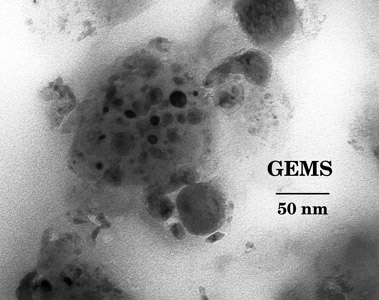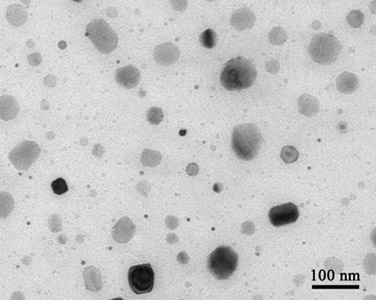Accueil
A&A press release: Interplanetary dust particles... (14 February 2006)
- Details
- Published on 14 February 2006
A&A press release
Released on February 20th, 2006
|
Interplanetary dust particles: reproducing GEMS-like structure |
Based on the article “The origin of GEMS in IDPs as deduced from microstructural evolution of amorphous silicates with annealing”, by C. Davoisne et al.
(Published in Astronomy & Astrophysics. )
In a coming issue, Astronomy & Astrophysics presents new laboratory results that provide some important clues to the possible origins of exotic mineral grains in interplanetary dust. Studying interplanetary grains is currently a hot topic within the framework of the NASA Stardust mission, which recently brought back some samples of these grains. They are among the most primitive material ever collected. Their study will lead to a better understanding of the formation and evolution of our Solar System.
Through dedicated laboratory experiments aimed at simulating the possible evolution of cosmic materials in space, C. Davoisne and her colleagues explored the origin of the so-called GEMS (glass with embedded metal and sulphides). GEMS is a major component of the primitive interplanetary dust particles (IDPs). They are a few 100 nm in size and are composed of a silicate glass that includes small, rounded grains of iron/nickel and metal sulphide (Figure 1). A small fraction of the GEMS (less than 5%) have presolar composition and could therefore have an interstellar origin. The remainder have solar composition and may have been formed or processed in the early Solar System. The varied compositions of the GEMS make it difficult to arrive at a consensus regarding their origin and formation process.

Fig. 1. Image of a GEMS in an interplanetary dust particle. Copyright: NASA

Fig. 2. Iron grain embedded in silicate glass.
In addition, the scientists found that, in the heated sample, practically no iron remains in the silicate glass, since all the iron has migrated into the metal grains. The team is thus able to explain why the dust observed around evolved stars and in comets is mainly composed of magnesium-rich silicates where iron is apparently lacking. Indeed, iron in metallic spherules becomes totally undetectable by the usual remote spectroscopic techniques. This work could therefore provide an important and new insight into the composition of interstellar grains as well.
The team shows that GEMS could form through a specific heating process that would affect grains of various origins. The process may be very common and could occur both in the Solar System and around other stars. The GEMS could thus have diverse origins. Scientists now eagerly await the analysis of grains collected by Stardust to find out for certain that some GEMS truly come from the interstellar medium.
The origin of GEMS in IDPs as deduced from microstructural evolution of amorphous silicates with annealing
by C. Davoisne, Z. Djouadi, H. Leroux, L. d'Hendecourt, A. P. Jones, and D. Deboffle
Published in Astronomy & Astrophysics volume 448, issue 1, pp. L1-L4 (DOI number: 10.1051/0004-6361:200600002)
Contact persons:
- Science:
Dr. Louis d'Hendecourt
“Astrochimie Expérimentale” - Institut d'Astrophysique Spatiale
Campus d'Orsay, Bat 121
91405 Orsay, cedex - France
Phone: +33 1 69 85 86 40 - Mobile: +33 6 13 16 25 38
Fax: +33 1 69 85 86 75 - Email: ldh (at) ias.fr
Dr. Hugues Leroux
Laboratoire de Structure et Propriétés de l'Etat Solide, Bat C6
Université des Sciences et Technologies de Lille
59655 Villeneuve d'Ascq - France
Phone: +33 3 20 33 64 16 - Email: Hugues.Leroux (at) univ-lille1.fr
- Press office:
Dr. Jennifer Martin
Journal Astronomy & Astrophysics
61, avenue de l'Observatoire
75014 Paris - France
Phone: +33 1 43 29 05 41 - Email: aanda.paris (at) obspm.fr
© Astronomy & Astrophysics 2006


